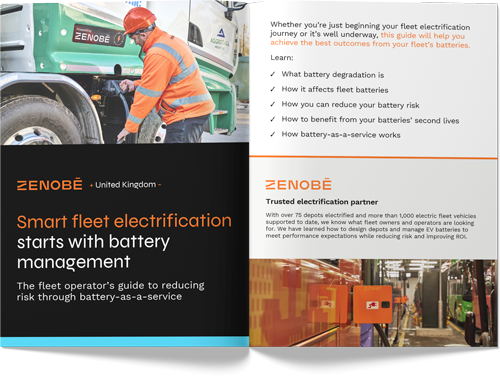Utilising Heavy Goods Vehicle (HGV) batteries as an asset

Fleet electrification is no longer an aspiration for heavy duty vehicle (HDV) operators: it’s a real target. But the question remains, how can a fleet operator make the business case for battery electric vehicles work? Ian Dennis, Business Development Director, explains.
How are heavy-duty vehicles funded?
Typically, HDV’s are funded through hire purchase agreements, finance leases, operating leases, and contract hire solutions which may also include maintenance.
The market is mature and these funding methods are well known and revolve around minimising the cashflow impact of acquiring new assets. Hire purchase provides ownership at the end of the facility, potentially allowing the operator to take the benefit – and risk – of the future residual value. The other forms of finance involve leasing products where the lessor typically retains the residual value.
Do battery electric trucks and vehicles have a residual value?
Diesel vehicles have been around for a long time. This longevity and experience means lessors can form a position on future residual values. Vehicles with large residual values or guaranteed buybacks from the manufacturer provide deferment of capital and a reduction in costs to the lessee – the operator.
However, now battery electric vehicles (BEV) have entered the market, the lack of established residual value for these vehicles presents a problem for funding.
How to secure more favourable financing by splitting chassis and battery
With no track record or previous history to utilise, manufacturers and funders are currently unable to determine future residual values and therefore can only provide facilities based on scrap value. For an operator, this means that already expensive BEV’s are more difficult to fund, and the cost could be prohibitive to their ambitions.
However, there are solutions available for operators to lease vehicles and enjoy some of the benefits of residual values. The battery market is well known to certain specialist lessors – such as Zenobē – who can define and implement residual values into a bespoke financing solution.
Unlike diesel vehicles, which are considered as one unit, BEVs can be split into two components – the chassis and the battery. Allowing a specialist lessor to take a residual value position on the battery can present significant cashflow benefits.
But the benefits are more than financial, they reduce risk. Electric vehicle batteries will eventually degrade beyond required performance levels and need to be replaced. Building replacement and performance guarantees into the financing allows the operator to fully utilise the vehicle for its entire lifetime with the risks managed by the lessor.
Why the current funding model for diesel trucks is not suitable in the era of battery electric vehicles
There is also a strong argument that BEVs should be funded over longer periods. The current 5 or 6-year funding model places pressure on operator’s cashflow and has largely been driven by available funding periods. With lessors managing batteries and offering guarantees, there is no reason why longer lifecycles could not be enjoyed by operators with vehicles being kept on fleets for 10 to 12 years.
Some operators will argue that their fleet refresh policy is far shorter, yet this again has been driven by diesel models with residual values and the ability to trade vehicles on – currently unproven in the BEV sector.
Battery technology advancements might deliver benefits such as improved energy density or increased payload and range. While there will be software updates, the suspension, steering and braking systems (including regenerative braking) will not change substantially in the coming years.
A BEV will likely have a much lengthier lifetime to run and deliver value for much longer. A longer life for the vehicle will be beneficial both financially – in terms of the total cost of ownership of the vehicle, and environmentally – in prolonging the usable life of these materials.
Building the business case for battery electric trucks and commercial vehicles
A holistic, total lifetime view is essential when considering the business case for switching to electric. Decoupling the battery from the chassis allows for specialist funders to offer solutions which de-risk the battery, the most expensive component on the vehicle and the one which carries the greatest risk for operators.
Building in battery replacement creates space for technological advancements and provides the operator with the certainty that the vehicle will meet operational requirements. Lessors such as Zenobē can remove risk and reduce costs for operators as they bring battery electric vehicles into their fleets. It’s not a one size fits all, but rather a modular approach, incorporating funding and charging solutions to maximise vehicle uptime.
Learn more in our whitepaper
Whether you’re just beginning your fleet electrification journey or it’s well underway, this guide will help you achieve the best outcomes from your fleet’s batteries. Learn:
- What battery degradation is
- How it affects fleet batteries
- How you can reduce your battery risk
- How to benefit from your batteries’ second lives
- How battery-as-a-service works

